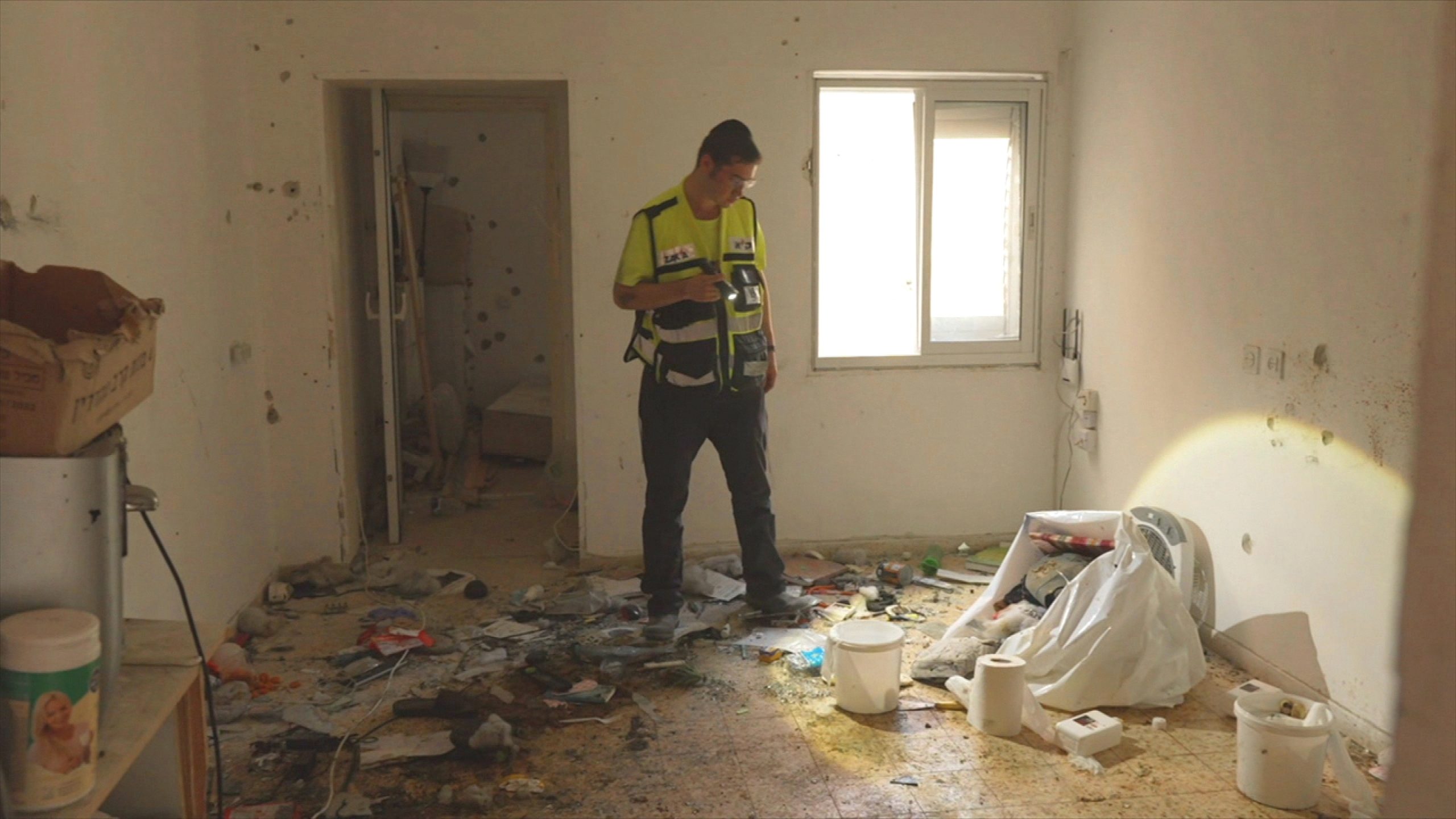Blood
Reporter’s notebook: In Israeli kibbutz rampaged by Hamas, volunteers still cleaning blood from homes
KFAR AZA, Israel — Editor’s note: This reporting contains extremely graphic descriptions.
It’s been just over a month since Hamas terrorists rampaged through the kibbutz of Kfar Aza.
But Jewish volunteers are still going through the bullet-riddled houses, cleaning and collecting every spot of blood and any bit of human remains left after the slaughter of roughly 60 residents in their homes there.
Many homes in the community of about 700 people that was established in 1951 by Jewish immigrants and refugees are burned and pockmarked with bullet holes and shrapnel from Oct. 7, when the Hamas terror group launched an unprecedented surprise attack on Israel.
ABC News visited Kfar Aza, a kibbutz where many homes are burned and pockmarked with bullet holes and shrapnel from Oct. 7, when the Hamas terror group launched an unprecedented surprise attack on Israel.
ABC News
Video evidence that has emerged since Oct. 7 shows Hamas fighters stormed through a security fence at the edge of Kfar Aza, shooting indiscriminately at residents, setting fire to homes and killing entire families. They went through houses, smoking out residents sheltering in their safe rooms and gunning them down. Several streets of the kibbutz are in ruins following the attack and the subsequent battle by the Israel Defense Forces to retake it.
Thousands of armed Hamas terrorists indiscriminately tortured and gunned down Israeli civilians in other kibbutzim and communities, while some launched a barbaric attack at an open-air music festival. More than 1,200 people have been killed and over 6,900 others injured on and since Oct. 7, according to Israeli officials.
Following Jewish tradition that dictates every piece of a person’s body should be buried, the volunteers in Kfar Aza now are painstakingly trying to find every spot of blood, piece of flesh or hair from those killed. When the volunteers from the ZAKA search and rescue organization find a blood-stained sofa or mattress, they cut out the blood-soaked area and place it in a bag. Plastic sacks filled with bloody items are piled outside houses.
We filmed with 23-year-old volunteer Israel Mayer as he led us through a charred house into a blackened safe room, where a thick pool of congealed, burnt blood covered part of the floor. He said the volunteers believed Hamas had set fire to the safe room and then killed the person sheltering inside.

Volunteers in Kfar Aza now are painstakingly trying to find every spot of blood, piece of flesh or hair from those killed.
ABC News

ABC News filmed with 23-year-old volunteer Israel Mayer as he led us through a charred house into a blackened safe room, where a thick pool of congealed, burnt blood covered part of the floor.
ABC News
As we spoke, we could hear huge blasts from an Israeli artillery battery firing close by into Gaza, which is only about 2 miles from the kibbutz.
When asked what he thought about Israel’s war in Gaza, Mayer said: “I think they should simply do almost what they did here.” Then he corrected himself, saying he regretted saying that.
“Not the same thing. But to neutralize whoever did this. The Jewish people are not vengeful,” Mayer said, adding he just wanted people to be able to live in the area peacefully again.
We met 63-year-old Ayelet Kazir down the street, where she was loading up garden plants from her home. She said she spent 36 hours barricaded in her safe room with Hamas gunmen in her house on Oct. 7. When the IDF finally arrived, they had to carry her out over booby traps planted there by Hamas, she said.
Her husband was dead, killed in a jeep on a road outside. She was gathering the plants to place by his grave later this week.
For years, Kazir said she had considered herself left-wing and supported outreach to Gaza. But now, she said, “It’s them or us.” She said she didn’t want Palestinian civilians to be hurt, but now there was no choice but war until the end of Hamas.

ABC News met 63-year-old Ayelet Kazir, who said she spent 36 hours barricaded in her safe room with Hamas gunmen in her house on Oct. 7.
ABC News
“All my life I used to be on the left wing,” she said, as an Israeli fighter jet rumbled overhead. “But now I realize it’s either them or us.”
Kazir said Israel had supplied electricity to Gaza and some permits to leave to work in Israel, including in the kibbutz.
“We just give. We just give. And we get this,” she said, gesturing at the wreckage around. She jumped as another IDF artillery boom rattled the area. “I don’t want to destroy nobody and if you asked me, I will be very happy if Gazan people will live here, will have peace together. But they don’t want it,” she said.
From the kibbutz, we could see toward the Gaza Strip, where thick, black smoke was rising. The heavy Israeli artillery fired every few minutes and warplanes were constantly above.
Israel retaliated against the Oct. 7 terror attack with a devastating bombing campaign and ground invasion of Gaza, putting it under total siege. More than 11,300 people have been killed, including thousands of children, and over 29,200 others injured in Gaza, according to the Hamas-run Gaza Health Ministry.
The IDF is regularly bringing buses of journalists to the kibbutz to refresh the horror of the Hamas attack for newly arrived reporters.
What happened there is feeding the rage driving Israel’s ferocious war against Hamas in Gaza. The horrors in Kfar Aza and the other kibbutzim, along with Hamas’ continued detention of 239 hostages (17 from Kfar Aza, the IDF says), have spread anger and fear through Israeli society, fostering widespread support for the war. It means that it is hard to see the horrors now being inflicted on Gaza will come to an end quickly.

